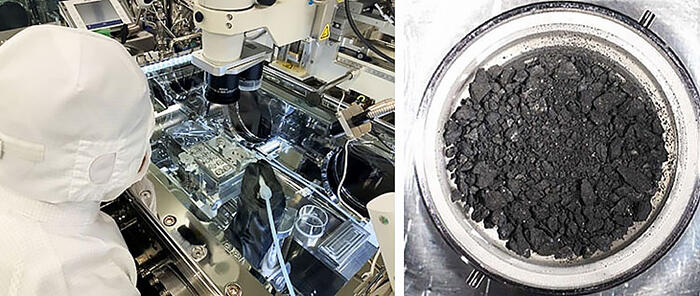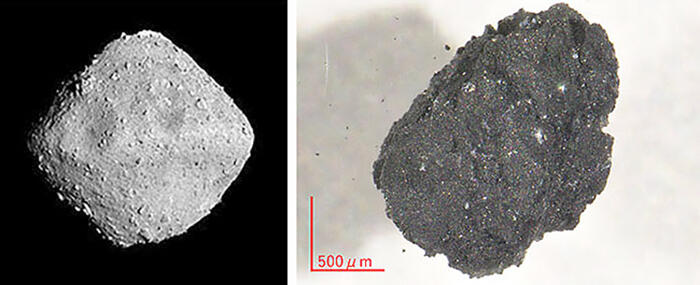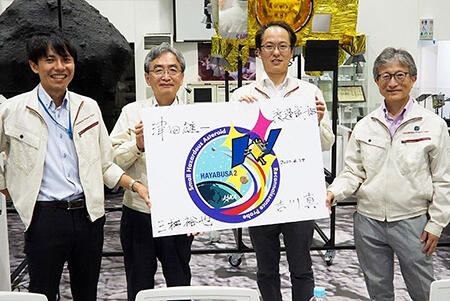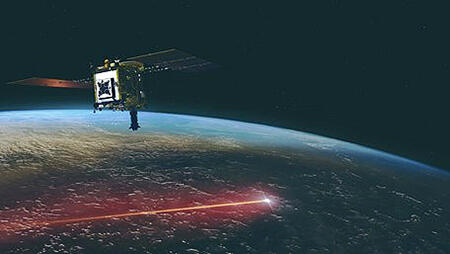More than a year and a half has passed since the Asteroid Explorer Hayabusa2 came back to Earth. Despite the extreme difficulties involved, Hayabusa2 successfully brought asteroid samples back with it, but doing so did not mark the end of the program. On the contrary, the scientific results are only now becoming apparent. Researchers have begun to carefully analyze the samples, and in June, revealed a discovery that is the key to deepening human understanding of the solar system. At the same time, the spacecraft has continued its journey to rendezvous with another asteroid in nine years' time, recently restarting its electrically powered ion engine to increase its speed. Taking the opportunity presented by these milestones in the program, the team held a press conference to announce changes to the project team structure.
"Truly incredible achievements": Nine World Firsts
"If I express it in numbers, the people coming after me (future Hayabusa2 plans) will get annoyed, so I'll put it this way... It's a gold star outcome, two thumbs up" At a press conference on June 29 at the Japan Aerospace Exploration Agency (JAXA) Institute of Space and Astronautical Science (ISAS) in Sagamihara City, Kanagawa Prefecture, Project Manager Yuichi Tsuda downplayed the result when asked by a newspaper journalist to rate the project's achievements so far on a scale of one to 10. However, he did present how the project has achieved all of its initial 11 success criteria, from using ion engine thrust to arrive at the asteroid to new scientific discoveries relating to the materials of earth, sea, and life, as well as achieving nine world firsts, including creating an artificial crater on an asteroid, accessing sub-surface material, and collecting materials from a C-type (carbonaceous) asteroid. "Looking back objectively, I believe they really are incredible achievements," he said with pride.

A capsule containing the samples that Hayabusa2 collected from the asteroid Ryugu returned to Earth on December 6, 2020, landing in the Australian desert. After releasing just the gas from the capsule on site, two days later the samples were brought to the ISAS. When they opened the capsule in a vacuum in the dedicated facilities, instead of the minimum of 100 milligrams of material they had been expecting, the team found approximately 5.4 grams, a significantly larger amount. Subsequently, basic observation and recording of many samples were carried out in a nitrogen-filled chamber. In May to June last year, some of those samples were distributed among eight teams, including six specialist teams conducting initial analysis, for ongoing analysis and recording. Distribution has also been carried out more widely in response to research proposals from scientists both within Japan and abroad, such as providing samples to the U.S. National Aeronautics and Space Administration (NASA). Samples have also been publicly displayed, such as through a roadshow in libraries and other public facilities around Japan.

(Right) Samples containing sub-surface material collected through creating an artificial crater in Ryugu
(both photos provided by JAXA)
It is "Japan's Duty" to show these materials from the Solar System's formative period
The first report from a specialist team was made on June 10. In it, the Chemical Analysis Team (including specialists from Hokkaido University and other institutions) announced findings characterizing the scientific value of the Ryugu samples. As a result of analyzing the 66 elements contained in the samples, it was ascertained that the samples were very similar to Ivuna-type carbonaceous chondrites, which are believed to retain the composition of elements from the period in which the solar system was formed.
The Ivuna meteorite fell in Tanzania in 1938. Only nine specimens of its type have been found on Earth, and they are considered the reference standard to understand the history of the solar system. The elemental composition and isotopic ratio of the Ryugu samples are extremely similar. Some of the differences are likely due to the meteorite falling to earth and becoming contaminated and weathered over the subsequent decades. Therefore, the Ryugu samples, which have avoided degeneration, are "the most primordial space samples mankind has ever obtained" (according to the Hayabusa2 team) and will likely be widely used in the future as solar system reference standards. It might also be necessary to revise findings reached to date based on meteorites. The team's findings have been published in the U.S. academic journal Science.
Professor Sei-ichiro Watanabe of Nagoya University, who studies planetary formation theory, and has worked as a Hayabusa2 project scientist, emphasized that "(Ivuna-type carbonaceous chondrites) are the meteorites that have been the foundation of solar system science to date. The types of elements and isotopic ratio in them have formed the basis of a wide range of hypotheses regarding planetary materials and distribution. The possibility of them becoming contaminated and weathered has been pointed out in the past, but it has been difficult to prove. This is one reason why the Hayabusa2 samples are so precious. We have also only analyzed about 10% of the sample volume on hand. We plan to use the remainder to thoroughly demonstrate what the original materials in the solar system were. Doing so is Japan's duty to worldwide planetary science."
Was its Parent an Icy Celestial Body? Ryugu's Origins Coming into View
It has been thought that Ryugu was formed by source celestial bodies colliding, fracturing, and the fragments coming together again. Through observations while Hayabusa2 was collecting samples combined with the analysis of samples carried out by other teams comprised of specialists such as from Okayama University, a more detailed history of Ryugu is coming to light. It seems that the source celestial bodies may be icy celestial bodies originating well outside Jupiter's orbit. Several million years after the birth of the solar system, ice degenerated due to the decay heat of radioactive isotopes, which at the same time created a variety of minerals and organic substances. Subsequently, they were pulled into the solar system by Jupiter and Saturn's gravity, collided with different types of asteroids, and the fragments came together to form Ryugu. During that time, the ice evaporated, creating asteroids of materials with many crevices. This is the scenario revealed through the analysis of Ryugu.

(Right) One of the samples collected by creating an artificial crater. It is 2.1mm in length and weighs 2 milligrams.
(provided by JAXA)
Based on this history as well as the detection of 23 types of amino acids including isomers in the samples, hypotheses postulating that asteroids like Ryugu brought the materials for the sea and life to Earth seem likely to attract renewed attention. The OSIRIS-REx sample-return spacecraft - which could be called the U.S. Hayabusa - is scheduled to return to Earth in September next year with samples from the asteroid Bennu. It is anticipated that comparison with the samples from Hayabusa2 will lead to even deeper findings. Professor Watanabe noted that "we want to convey the overall image again once the initial findings are all available."
In the field of space science, these new developments involving sample-return spacecraft are attracting broad attention. At the same time, the data these craft deliver to Earth also contributes to the body of scientific knowledge, through subsequent painstaking analysis over months and years, and the academic articles that researchers write based on it. The moon rock collected by the U.S. Apollo program half a century ago is even now still the focus of intense scrutiny from researchers around the world. Similarly, not all of the samples collected by Hayabusa2 will be immediately distributed to scientists. 60% of them are planned to be stored for future use, for a time when analysis technology is likely to have advanced.
The Journey Continues: Another Nine Years towards a Small Asteroid
July 8th, 2022 marks 2,774 days since Hayabusa2 was launched. The spacecraft continues its mission, now flying towards a rendezvous with asteroid 1998KY26. On June 28, operation of its ion engine was restarted to increase the craft's speed, and the engine is planned to run until around October. Hayabusa2 will next conduct a fly-by of the minor planet 2001CC21 in July 2026, and while making observations, use its gravity to accelerate. After approaching the Earth twice (in December 2027 and June 2028), Hayabusa2 will arrive at 1998KY26 in July 2031.
1998KY26 is a spherical asteroid approximately 30 meters in diameter, significantly smaller than Ryugu (which is around 1 kilometer in diameter at its equator) and has a rotational period of only around 10 minutes. The Hayabusa2 mission aims to ascertain how to explore celestial bodies of this type. Asteroids of this size collide with the Earth every hundred to several hundred years, and this exploration may be useful in researching methods to mitigate asteroid damage. This time, Hayabusa2 is on a one-way mission, and will not return to the Earth again.
On June 30, the Hayabusa2 Project Team was disbanded, formally transitioning to the Extension Project Team, which aims to rendezvous with 1998KY26. Rather than reporting directly to JAXA as previously, the new structure lies under the JAXA ISAS. Tsuda will continue to lead as Project Manager, but Senior Research and Development Fellow Yuya Mimasu has been newly appointed as Space Probe Operations Leader.
Mimasu has been involved with Hayabusa2 for over 10 years, making a significant contribution to spacecraft navigation and control. At the press conference he expressed his passion for the project, explaining that "Hayabusa2 has already exceeded its design life, and something could go wrong at any time. I want to do everything I can to keep operation moving forward steadily, and bring you all good news for as long as possible."

The team members all signed the logo poster after the press conference.
On the left is Space Probe Operations Leader Yuya Mimasu; June 29, JAXA ISAS in Chūō Ward, Sagamihara City
Helping to Build Knowledge: The Ultimate Basic Science Using Leading-Edge Technology
The question is often asked about how science and technology will contribute so that humanity can survive and thrive. 18 months ago, I (the author) punctured the celebratory mood at the Hayabusa2 return press conference by asking Tsuda a tough question: Does this type of space exploration actually benefit all of humanity, over and above making a few space fans happy? It is to my regret that I wasn't able to effectively incorporate his response into my articles at the time. Despite the passage of time, it would still be a shame not to feature his response, and it provides a fitting conclusion to this article.
"I believe that scientists benefit humanity and lead the world in a positive direction by bringing knowledge to light. Discovering knowledge speaks to the curiosity and innate character of humans, and by doing so, scientific inquiry works beautifully and in a positive direction. It's possible that everyone has intellectual curiosity, but not everyone can carry out these scientific missions. You need time and a platform to execute from. As scientists, we are fortunate to have or be able to imagine those things, so we share these ideas with the world. Science does not always aim to be immediately useful to the task at hand. This is the ultimate basic science, using leading-edge technology. I am convinced that what we have discovered will definitely in some form enrich the wisdom and knowledge of all of humanity."

(provided by JAXA)
KUSAKA Takeo / Science Portal Editorial Office
Original article was provided by the Science Portal and has been translated by Science Japan.




